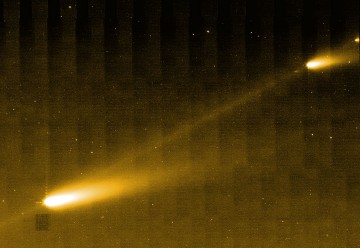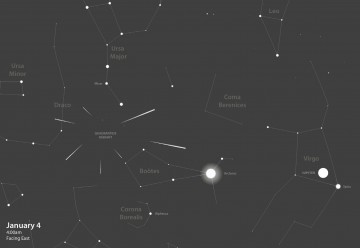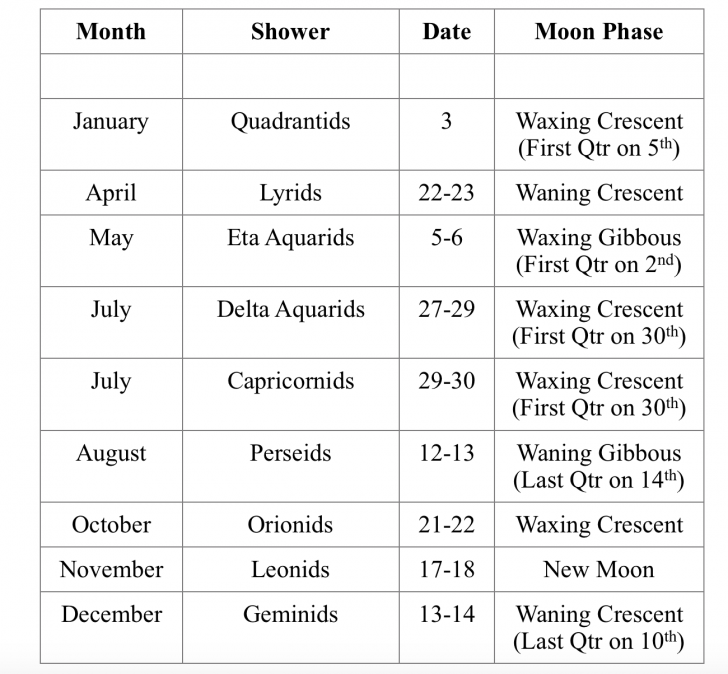Huestis: Astronomical Highlights of 2017
Sunday, January 01, 2017

Fortunately, a day or two’s drive will position you within the 65-mile wide path of totality. Flights to observing locations farther to the west and northwest could possibly be accomplished. However, regardless of what mode of transportation you choose, lodging anywhere near the path of totality could be non-existent or outrageously expensive. One hotel chain I contacted back in July 2015 was originally contemplating charging $1000 per night and requiring a three-night minimum!! They later settled for $899.
So if you haven’t already booked lodging, you may not find anything within a 150 mile drive of the path of totality, or if you do find an establishment you may have to mortgage your house to finance it. Perhaps folks will not book lodging with such high rates and the prices may drop just prior to the event. I will write an extensive column about this Great American Total Solar Eclipse in my August column. Check out this interactive eclipse map that shows the entire path through the United States:
You can zoom in on any location within the eclipse path to get an idea of how long totality will last, or determine how much of the solar disk will be covered by the Moon outside of the path of totality.
While the total solar eclipse is most definitely the highlight of 2017, there are many other astronomical happenings waiting to be observed. The following is a sampling of events to come.
On January 4 at 9:17am the Earth is at perihelion (closest to the Sun) for 2017 at 91,404,322 miles. This might seem counterintuitive, but the northern hemisphere is titled away from the Sun at that time and we experience winter. On July 3 at 4:11pm the Earth will be at aphelion (farthest from the Sun) at 94,505,901 miles. This three million mile plus difference in the Earth’s elliptical orbit does not affect our global temperature.

While you can see these meteors anywhere in the sky, their radiant point (the area of sky from where the meteors appear to originate) is not far from the end star, Alkaid, of the Big Dipper’s handle. Find a dark sky location as far away from city lights as possible. Also shield your eyes from local streetlights or neighbors’ security lights. From midnight till dawn, this area of sky will rise higher and higher above the northeast horizon, and by 4:00am it will be almost at zenith (directly overhead). You’ll know you’ve spotted a Quadrantid meteor if you can trace its trajectory back to the radiant point. I’ve seen many Quadrantids shoot more than halfway across the sky! Be sure to dress warmly and do not fall asleep out there under the shooting stars. If the morning of the 3rd is clouded out, you still may catch a few Quads on the morning of the 4th.
The schedule of the other major meteor showers for 2017 appears in a table at the end of this column.
Venus will continue to be that bright beacon seen in the western sky after sunset as 2017 begins. On January 12, it will be at its highest position above the horizon. Telescopic observers should observe Venus as it runs through its phases. At the beginning of January Venus will be just more than half illuminated, looking like a waxing gibbous Moon. The phase will slowly decrease, eventually looking like a waxing crescent as the planet moves towards the horizon and its conjunction with the Sun.
During the early evening of February 11 there is an unremarkable penumbral eclipse of the Moon. The Moon will slide deep into the Earth’s lighter shadow, but will just miss the Earth’s dark umbral shadow. The top portion of the Moon’s disk will look slightly dusky.
Amateur astronomers will be observing Jupiter and Saturn between midnight and dawn during the first few months of the year. By mid March giant Jupiter will be visible high in the eastern sky around 10:00pm. On April 7 Jupiter will be at opposition, rising at sunset. Saturn will likewise be an early morning telescopic target at the beginning of 2017. Saturn will rise before midnight during May, and will reach opposition on June 15. Stargazers will be fortunate to have two bright planets to observe for a couple of months. Jupiter will be visible until late July or early August, depending upon one’s horizon. Saturn will be visible through until mid to late October, again depending upon one’s horizon. In October Saturn’s rings will be at their maximum tilt towards the Earth—27 degrees. We’ve been looking at the north face of Saturn’s rings since the Earth passed above the ring plane in 2009.
Another beautiful celestial sight will be a very slender waning crescent Moon to the lower right of Venus before sunrise on May 22. Notice the earthshine that illuminates the lunar surface not receiving sunlight. Why does this phenomenon occur? If you were on the Moon looking back at the Earth, the Earth would be in a waxing gibbous phase, just before Full Earth (the phase of the Earth is always the opposite phase of the Moon).
On June 9 we experience a Minimoon, the smallest Full Moon of 2017. This scenario is in contrast to a Supermoon! And like a Supermoon, this mini version would not even be recognized as such by the majority of folks without the media hype.
For a nice view of two planets, look towards the eastern sky before sunrise on November 13. Less than ten degrees above the horizon will be a conjunction of brilliant Venus and Jupiter. The pair will be separated by less than one full moon diameter. Get out your cameras and snap an image of this beautiful event.
Furthermore, like 2016, there are multiple occultations of Taurus’ bright star Aldebaran. They occur on September 12, November 5, and December 30. I will bring the details of these events to your attention in their respective monthly columns.
And our solar system’s closest planet to the Sun, Mercury, will become visible several times in the evening after sunset and also in the morning sky before sunrise throughout the year.
So as you see, 2017 has a lot to offer the amateur and casual stargazer alike. Let’s hope the majority of these celestial events elicit the full cooperation of Mother Nature.
Some of the topics highlighted in this column may be covered in depth as an event date approaches.
Please clip and save the following chart showing the observing prospects for the 2017 meteor showers. These displays of shooting stars only require your eyes, dark skies, and patience to enjoy.
Meteor Shower Prospects for 2017

Keep your eyes to the skies for 2017 and always.
Happy New Year!
David A. Huestis




 Delivered Free Every
Delivered Free Every
Follow us on Pinterest Google + Facebook Twitter See It Read It